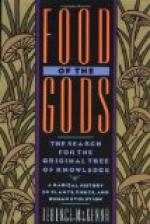[Illustration—Colour Plate: CACAO PODS]
II. ITS GROWTH AND CULTIVATION.
[Illustration—Drawing: CACAO HARVESTING.]
Cocoa is now grown in many parts of the tropics, reference to which is made in another chapter. The conditions, however, do not greatly vary, and there are probably many lands in the tropical belt where it is yet unknown that possess soil well suited to its extended cultivation.
The cacao-tree grows wild in the forests of Central America, and varieties have been found also in Jamaica and other West Indian islands, and in South America. It does not thrive more than fifteen degrees north or south of the equator, and even within these limits it is not very successfully grown more than 600 feet above the sea-level; in many districts where sugar formerly monopolized the plains, it was supposed that cocoa needed an altitude of at least 200 feet, but experiments of planting on the old sugar estates and other low-lying places are generally successful where the soil is good, as in Trinidad, Cuba, and British Guiana. It has been found that the expense saved in roads, labour, and transit on the level has been very considerable in comparison with that incurred on some of the hill estates.
In appearance the cacao-tree is not greatly unlike one of our own orchard trees, and trained by the pruning knife it grows similar in shape to a well-kept apple tree, no very low boughs being left, so that a man on horseback can generally pass freely down the long glades. Left to nature, it will in good soil reach a height of over twenty feet, and its branches will extend for ten feet from the centre.
[Illustration—Black and White Plate: Ceylon: Nursery of Cacao Seedlings in Baskets of plaited Palm Leaf.]
The best soil is that made by the decomposition of volcanic rock, so that it is a common sight to find areas strewn with large boulders turned into a cocoa plantation of great fertility; but the best trees of all lie along the vegas which intersect the hills, where the soil is deep, and the stream winding among the trees supplies natural irrigation. The tree also grows well in loams and the richer marls, but will not thrive on clay and other heavy soils.
The cacao is one of the tenderest of tropical growths, and will not flourish in any exposed position, for which reason large shade belts are left along exposed ridges and other parts of a hill estate, thus greatly reducing the total area under cultivation, in comparison with an estate of equal extent on the level plains, where no shade belts are necessary.
The beans are planted either “at stake,”—when three beans are put in round each stake, the one thriving best after the first year being left to mature,—or “from nursery,” whence, after a few months’ growth in bamboo or palm-leaf baskets, they are transplanted into the clearing.




